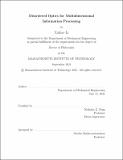Disordered Optics for Multidimensional Information Processing
Author(s)
Li, Xinhao
DownloadThesis PDF (8.635Mb)
Advisor
Fang, Nicholas X.
Terms of use
Metadata
Show full item recordAbstract
Photonic platforms with multiplexing capabilities are of profound importance for high-dimensional information processing. With the rapid expansion of data volume, growing pressure on the sensor and post-processing hardware calls the development of physical pre-processing interfaces. Complex photonic systems aim to address the challenges as the interfaces between raw signals and sensors, which improve the efficiency of information reconstruction. In this thesis, we explore disordered photonic devices for multidimensional information processing and compatible fabrication techniques.
The first part of the thesis is about diffractive optical elements (DOE) for spectral imaging. We designed a spatially modulated DOE filter that can efficiently sample in the Fourier transformed domain and facilitate spectral image reconstruction. The DOE layer distinguishes the main Fourier spectral components, and the second spatial modulation layer mediates spectral aliasing. Unlike conventional snapshot spectral imagers, our design does not require sub-super-pixel-level sensing, which enables the efficient usage of sensor resolution. We further demonstrated a grayscale stencil lithography technique for efficient and customizable manufacturing of DOE or multilayer optics with spatial thickness variation.
The second part of the thesis is about scattering reservoir computers (RC). Complex optical medium shows great potential for large-scale optical RC thanks to the intrinsic parallelism and scalability. We identify the trade-off between the fading memory and non-normality of scattering RC, which determines their memory capacity and resistance to noise. Further, we proposed a transient amplification method to fully harness the high noise resistance and high dimensionality of non-normal scattering RC. We further developed a dynamic hydrogel scatter, and projection lithography method for 2D patterning of gain/loss materials, which are promising for applications in dynamic light modulation and re-configurable optical computing.
Date issued
2021-09Department
Massachusetts Institute of Technology. Department of Mechanical EngineeringPublisher
Massachusetts Institute of Technology